Shopify vs Ecwid: Which Platform is Best For Scaling DTC Brands?

Your sales platform is what enables your ecommerce business to operate, grow, and thrive. It sets the stage for your overall business strategy and affects everything that comes after launch.
Your platform determines how you connect with customers, manage inventory, process payments, and even how you fulfill orders.
That’s why choosing a reliable solution is paramount for ecommerce success.
In this article, we’ll compare two popular options, Shopify and Ecwid, going through their pros and cons, features, and more.
Read on to learn:
#cta-visual-pb#<cta-title>Design your ideal store with Shogun<cta-title>Use our drag-and-drop page builder to easily achieve the website you’ve envisioned.Start building for free
What is Shopify?
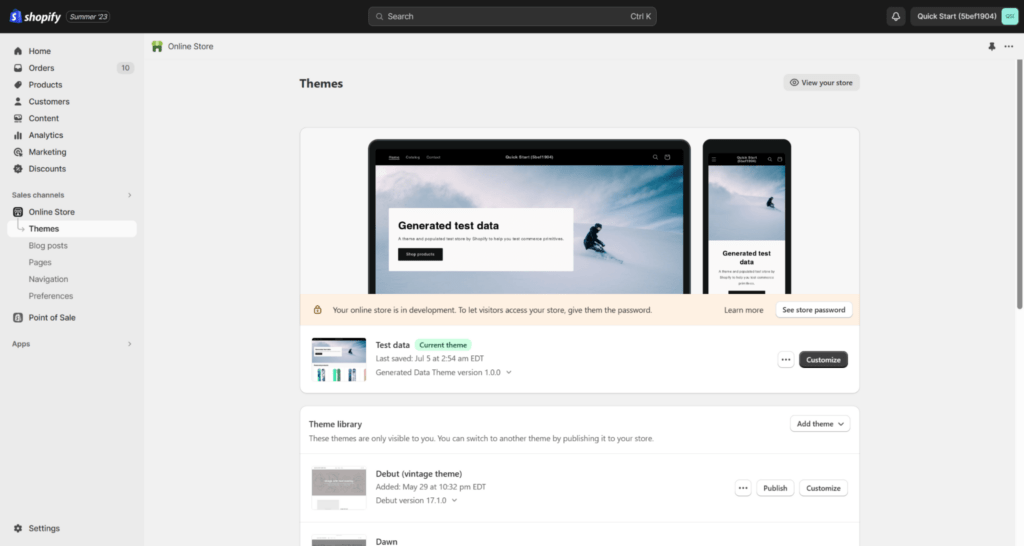
With more than four million stores running on Shopify, this ecommerce platform is widely recognized and a popular choice for merchants around the world.
The platform guides users through store setup, design, inventory management, fulfillment, payment processing, marketing, and more.
Along with an intuitive interface, tech-savvy merchants and newbies alike can feel comfortable building their online presence.
What is Ecwid?
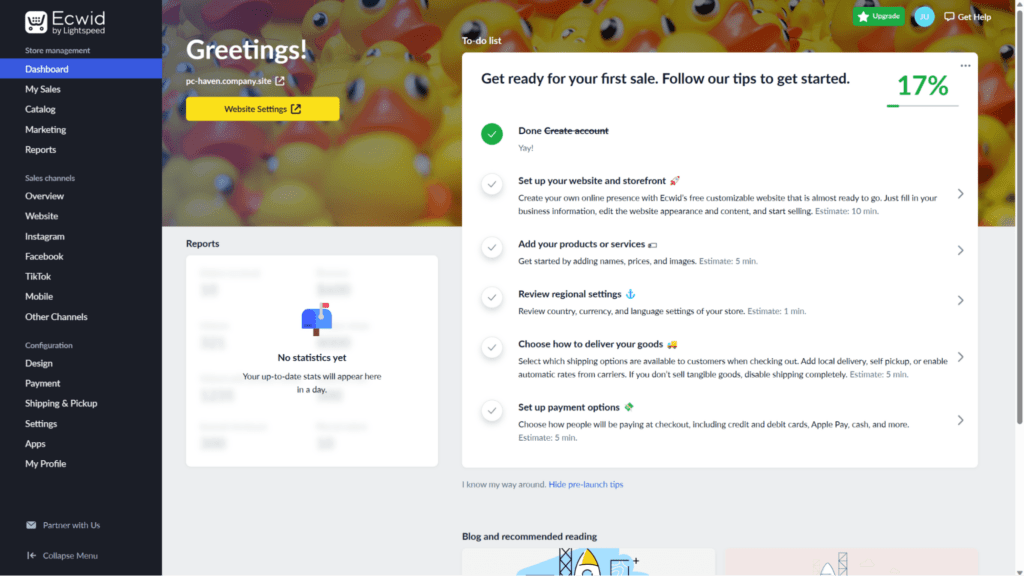
Ecwid takes a different approach from Shopify’s heavy DTC focus by emphasizing their multi-channel capabilities.
Their website states, “Start Selling Everywhere Online” and boasts the ability to “control everything from a single platform with centralized inventory, order management, and pricing.”
The platform is designed to simplify your website’s integration into multiple sales channels, including:
- Social platforms like Instagram, Facebook, and TikTok
- Online marketplaces like Amazon and eBay
- Google platforms
- Mobile
Ecwid’s “add-to-any-site” convenience makes it a versatile option, especially if you’re a small brand looking to establish multiple avenues for online selling.
Shopify vs Ecwid: The pros and cons
Before we delve into the nitty-gritty, we’ve provided a snapshot of each platform’s advantages and disadvantages.
Pros and cons of Shopify
Being a powerful, well-rounded platform, Shopify has many upsides and its share of downsides.
| Pros | Cons |
|---|---|
| Supports growth and scalability | Third-party transaction fees without Shopify Payments |
| Extensive design capabilities | Paid options result in higher monthly costs |
| Robust app ecosystem | File size limitations |
| Omnichannel selling tools | Complex setup for advanced capabilities |
Pro: Scalability
Shopify is massive and globally recognized in the ecommerce industry, with a sophisticated feature set that’s able to scale alongside your business.
This is evident in their pricing, which has a plan for “medium to large businesses” and another one that goes further “for high-volume businesses.”
Pro: Design
Shopify offers various free and paid themes so you can apply your favorite look.
You can take design and branding a step further with page builders that allow you to customize every pixel on your product pages, landing pages, and other site elements.
#cta-visual-pb#<cta-title>Create the store you’ve been dreaming about<cta-title>Turn your website dreams into reality with Shogun Page Builder for Shopify.Start building for free
Pro: App ecosystem

The Shopify app store boasts more than 8,000 apps, all of which expand upon the platform’s functionality.
With so many options to choose from, alongside Shopify’s own API, merchants are sure to find a solution that helps them do exactly what they need.
Pro: Omnichannel selling tools
In addition to an online store, Shopify also has a POS system that merchants can implement in their physical locations.
Integrations with popular sales channels and social media platforms make Shopify one of the best options for merchants who want to be everywhere.
Con: Transaction fees

Unfortunately, all those incredible features come at a cost.
Unless you use Shopify Payments as your payment gateway, you’re looking at anywhere from a 0.15%–2% third-party transaction fee tacked onto every purchase—that’s on top of all your other fees.
As you’ll soon see, transaction fees aren’t something you have to expect from every ecommerce platform.
In addition to Ecwid, WordPress, and WooCommerce are just some of the transaction-free ecommerce website builders you can choose from.
Con: Surprise expenses
Shopify users might also receive an unpleasant surprise when setting up their stores and apps.
Although Shopify has many free themes and apps, most options (that come with more functionality) have additional costs associated with using them.
For some context, Shopify boasts almost 160 themes, but only 12 of which are free.
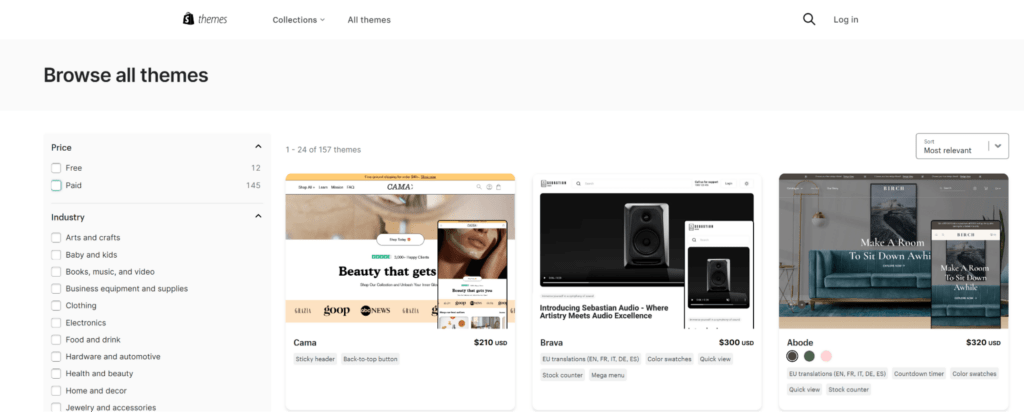
Con: Limited file sizes
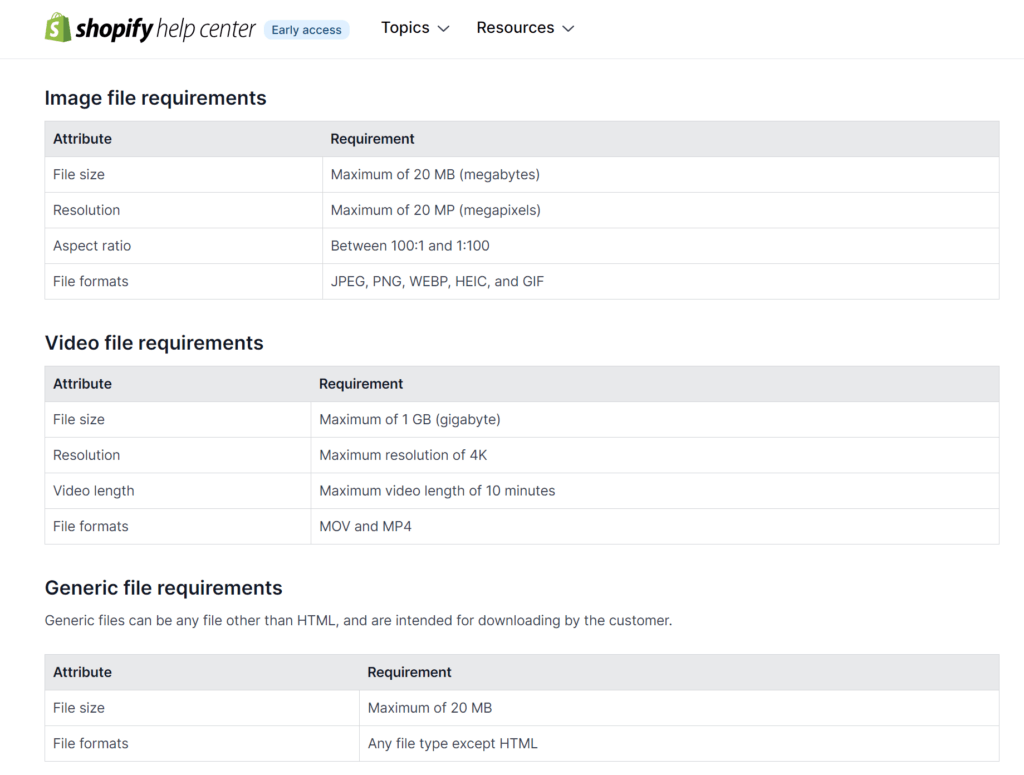
Shopify limits file sizes to 20 MB in most cases, with video files allowed to reach up to 1GB.
For brands that rely on larger or longer videos to support sales, this could affect your conversion rates and how you share information with customers.
For example, if you sell products that come with help videos longer than 10 minutes, you’ll need to find a different way to share those files.
Con: Cumbersome advanced store configurations
Although Shopify is generally easy to use and set up, you may become frustrated when trying to tap into the more advanced store configurations.
Despite its extended functionality with apps, Shopify remains a platform built to run in a specific way.
Some users have found that “you still have to use apps and make custom code to fit your business needs, [and] hiring a developer is much cheaper to fit all the specifications on checkout, product pages, etc.”
That means you’ll likely have to employ more apps and custom settings than you anticipated to set up your Shopify store the way you want.
Compare this to, say, WooCommerce or a custom-built website where you have full control over all functionality, and you may find yourself limited in what you can do.
Pros and cons of Ecwid
Ecwid is founded on convenient integration with various channels and has the pros and cons to match.
| Pros | Cons |
|---|---|
| Seamless integration with existing websites | Integrations with other platforms require higher plans |
| Easy to set up and use | Less design flexibility |
| No transaction fees | Limited ability to scale |
| Generous file size allowance | Fewer apps and integrations |
Pro: Seamless channel integration
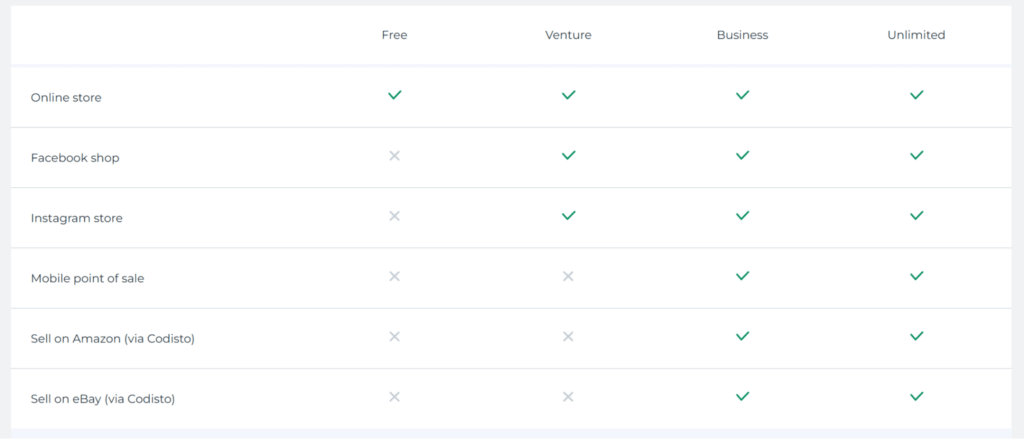
Ecwid is designed to enable you to sell anywhere easily.
That means you can tap into everything from your DTC store to Facebook, Instagram, and even a mobile store—all from their native platform.
Pro: Simple setup
“I looked into and tried Shopify in the past but very quickly realized this was not as easy as Ecwid for me … I really enjoy the user experience as a whole. It is very simple to understand and get a store up and running.”
— Software Advice reviewer
Ecwid’s core focus is the ability to sell seamlessly across multiple channels.
As a result, they strip the bells and whistles from their platform to make it as simple to use and understand as possible. That makes setup a breeze and lightning fast.
Pro: No transaction fees

One of the most noteworthy aspects of using Ecwid is the effect on your bottom line. Ecwid has a simple monthly pricing plan with no additional transaction fees.
Pro: Generous file size allowance
Ecwid allows you to sell digital products on their platform (such as ebooks and art downloadables) and accept files uploaded from customers (e.g., designs for custom prints).
You can add as many files as needed per product, and each can be up to a whopping 25 GB.
Likewise, customers can upload various file types up to 25 GB in size, one of the most generous file size allowances we’ve seen.
Con: Additional sales channels require paid plans
If you intend to use Ecwid to sell exclusively on your online store, you can use their free plan to hit the ground running at no cost.
However, if you want to integrate social sales channels, a mobile point of sale, or marketplaces like Amazon and eBay, it’ll cost you.
Con: Less design flexibility
Ecwid is built to be streamlined and easy to use, with exactly what you need to grow and not much else.
Compared to Shopify’s robust design features, templates, and apps, Ecwid comes with less flexibility to customize your website and mold it to your brand.
Con: Limited ability to scale
Michael Power, CMO of DTF Transfers, sums it up best:
“At the end of the day, Ecwid doesn’t have the comprehensive utility of Shopify. Its design customization options are more limited and, as … a growing company, scalability [is] definitely a concern.”
Ecwid is a great, simple platform for small to medium-sized companies but lacks all the features you’d need to rely on (or have available) as you grow.
Con: Fewer apps and integrations
Finally, Ecwid doesn’t have as robust an app ecosystem as Shopify (but, then again, who does?).
Shopify vs Ecwid: Feature breakdown
To help you understand Shopify and Ecwid’s pros and cons, here’s a quick overview of their key features, showing which ones have the upper hand in each aspect.
| Feature | Details | Winner | Reason |
|---|---|---|---|
| Pricing | Shopify’s Fulfillment Network opens access to the platform’s transportation partnerships, which handle fulfillment and shipping. Ecwid’s option is built on discounted USPS shipping but lets you add other fulfillment options. | Ecwid | Free plans available, and more affordable paid plans |
| Ease of use | Shopify and Ecwid implement ecommerce-oriented designs for a seamless user experience (UX). | Tie | Both platforms, being designed for ecommerce, are easy to use with simple UX to create products, set pricing, and more |
| Payment options and fees | Shopify charges transaction fees when using third-party payment processors. Ecwid supports various payment providers and doesn’t charge transaction fees. | Ecwid | No transaction fees on all plans |
| Ecommerce features | Shopify boasts an extensive toolkit that unlocks unlimited scalability. Ecwid lacks expandability options. | Shopify | Offers boundless extensibility for growing brands |
| Customization and branding | Shopify offers flexible, user-friendly design capabilities. Ecwid’s customization is more limited and less intuitive. | Shopify | Provides versatility for aligning with brand aesthetics |
| Marketing and SEO | Shopify enables search engine optimization (SEO), content marketing, social media selling, consumer behavior analysis, and more. Ecwid focuses on advertising on Google sites and social platforms, plus offering discounts and email marketing. | Shopify | More expansive marketing toolkit |
| Integrations and apps | Shopify’s vast library of apps lets you add countless functionalities to your store. Ecwid’s app collection has a shallower offering. | Shopify | Broad selection of integrations |
| Multichannel selling | Shopify and Ecwid can connect with social platforms and online marketplaces. Compared to Ecwid’s POS, Shopify’s solution offers more robust software and hardware for in-person selling. | Shopify | Shopify POS is more feature-rich |
| Shipping and fulfillment | Shopify’s Fulfillment Network opens access to the platform’s transportation partnerships, which handle fulfillment and shipping. Ecwid’s option is built on discounted USPS shipping, but lets you add other fulfillment options. | Shopify | Encompasses every shipping and fulfillment need |
| Security | Both platforms are PCI DSS and GDPR compliant. Shopify takes extra steps to provide a transparency report and receive SOC 2 Type II and SOC 3 reports. | Shopify | Implements additional security measures |
| Customer support | Shopify provides 24/7 support through multiple channels. Ecwid’s support is restricted according to your chosen plan. | Shopify | Assistance is always available |
With the above summary in mind, let’s dive into a more detailed comparison. We’ll also hear why certain industry leaders chose a specific platform.
Pricing
Shopify and Ecwid offer tiered pricing plans that cater to various business sizes and needs.
Shopify Basic starts at $39 per month, whereas Ecwid has a free plan available and an entry-level paid plan that starts at $19 per month.
Shopify does have a $5 plan, but it doesn’t include an actual online store, just social selling.
Shopify
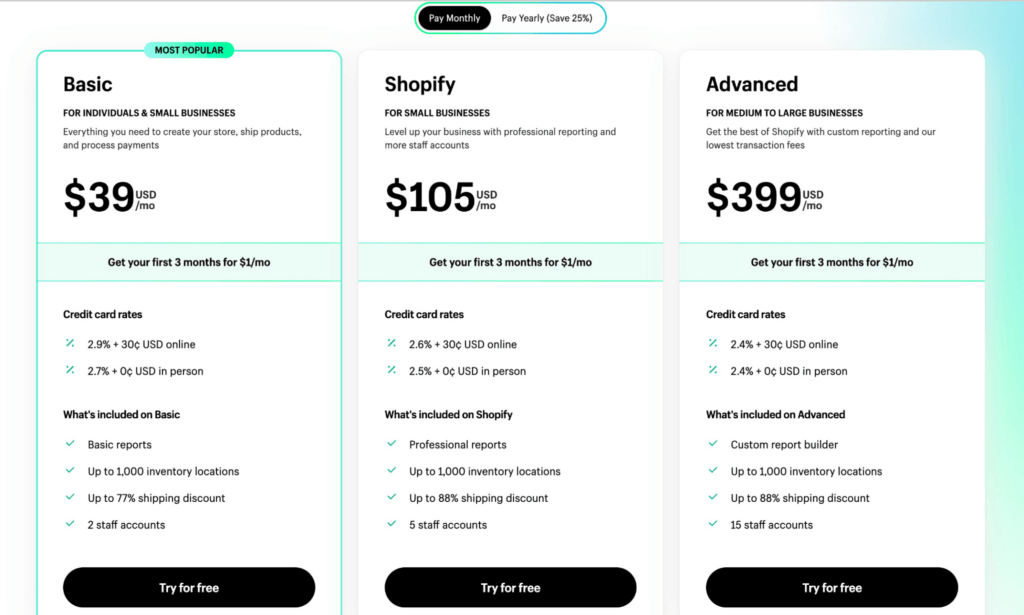
- Starter: $5/month
- Basic: $39/month
- Shopify: $105/month
- Advanced: $399/month
- Shopify Plus: Starts at $2K/month
If you want to dive deeper, we have guides on how to choose the right Shopify plan and how they compare to Shopify Plus.
Ecwid
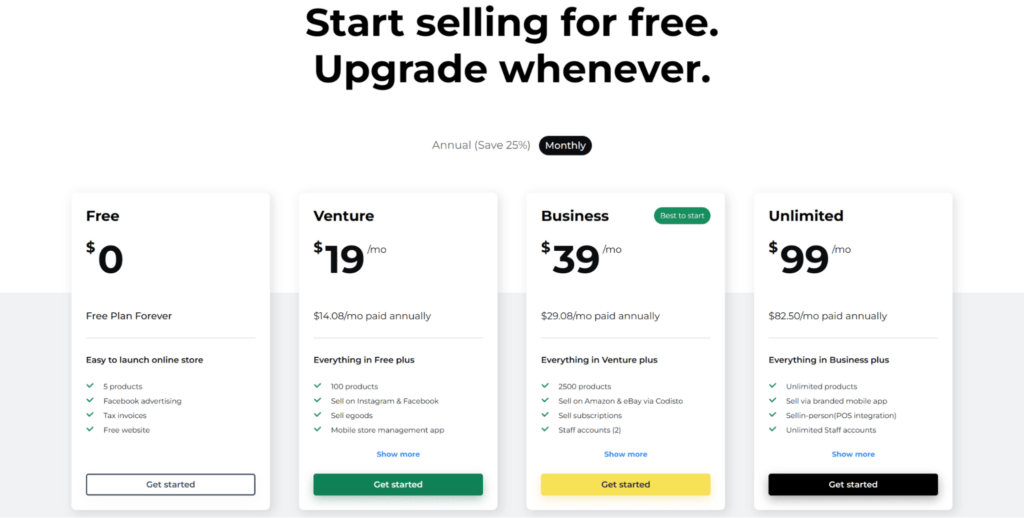
- Free: $0/month
- Venture: $19/month
- Business: $39/month
- Unlimited: $99/month
Winner: Ecwid
“Ecwid stands out because it has a basic free version that you can try out—and it may even be enough if your business is small…. [Even] solopreneurs can probably make it work.”
— Michael Power, CMO of DTF Transfers
As Power mentioned, Ecwid’s low prices offer easy entry into the ecommerce space. The free plan lets you test the platform without a commitment, which is great for individual and new sellers.
One caveat is that the Shopify basic plan and Ecwid business plan are both $39 per month, but the Shopify plan comes with more allowance for products.
At this price point, Ecwid merchants are limited to 2500 products, whereas Shopify allows unlimited products even at their Starter plan. Once you hit the need for more SKUs, it may make more sense price-wise to go with Shopify.
Ease of use
Being geared toward ecommerce, Shopify and Ecwid are tied in terms of UX. Both platforms are beginner-friendly and ideal for those wanting to avoid complex setups.
Navigation
Shopify’s admin is easy to work in, with each function neatly categorized and simple to find due to the minimalistic design.
Selecting a section like Products opens up more options and takes you to its respective interface.

The same applies to Ecwid.
Since everything is readily accessible, you don’t have to worry about becoming lost using either platform.

Adding products
Adding products on Shopify is straightforward as well.
You can input all the necessary information—from titles and images to variants—in one place. You can also create collections to organize your catalog.

Ecwid follows a similar approach but sorts the product details you can add into separate tabs.
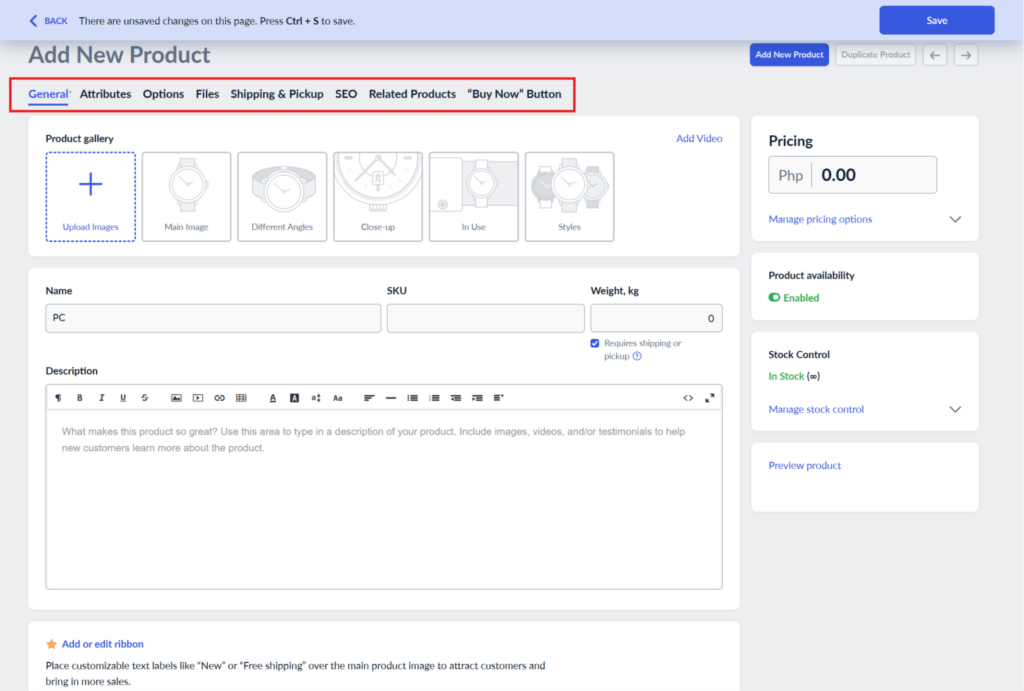
Channel integrations
Connecting your website to another online channel is also convenient. With Shopify, it only involves installing the app for the marketplace or sales channel.
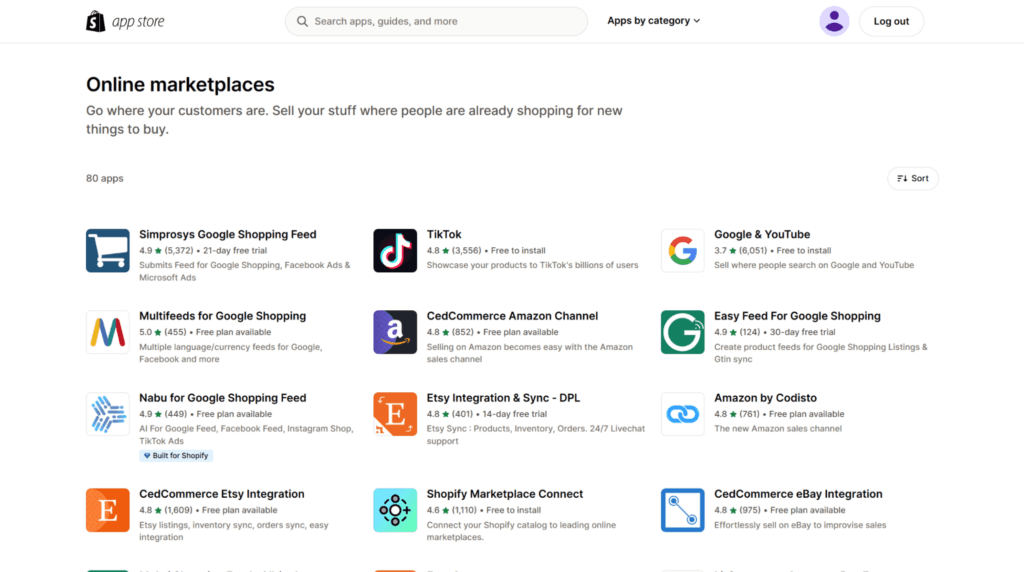
For Ecwid, choosing a Venture plan lets you connect with social platforms, while higher-tier plans also allow you to integrate with online marketplaces.
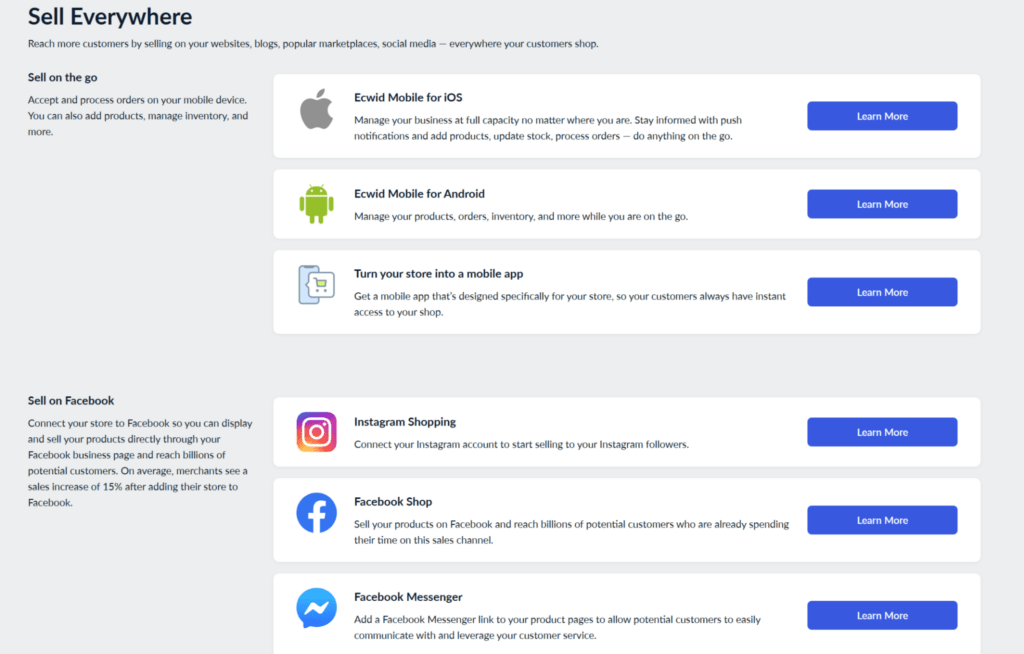
Other store aspects
With Shopify, you can tweak your account details, user permissions, payments, checkout, fulfillment, and more through a settings menu accessible from your admin.

Similar options can be found on Ecwid, located under the menu’s Configuration section. This is where you can edit components like your store design and user profile.
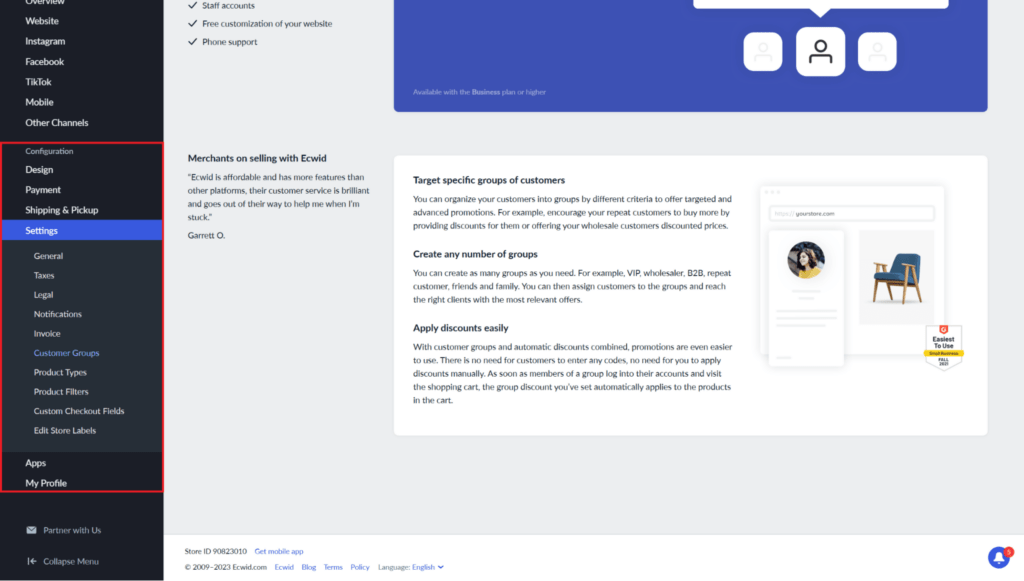
Winner: Tie
Both Shopify and Ecwid are designed to be easy to use.
The better choice for your company will depend on what you’re looking for: more functionality (Shopify) or a simpler interface (Ecwid).
Payment options and fees
It’s important that you provide the payment options and security your customers want, while still maintaining healthy profits.
Shopify

The Shopify Payments gateway eliminates fees for third-party transactions processed via:
- Shopify Payments
- Shop Pay
- Shop Pay Installments
- Paypal Express
You won’t incur charges for manual methods like cash, cash on delivery (COD), or bank transfers.
Choosing external payment providers, however, nets you respective fees of 2%, 1%, or 0.5% for Shopify’s Basic, Shopify, and Advanced plans.
Ecwid
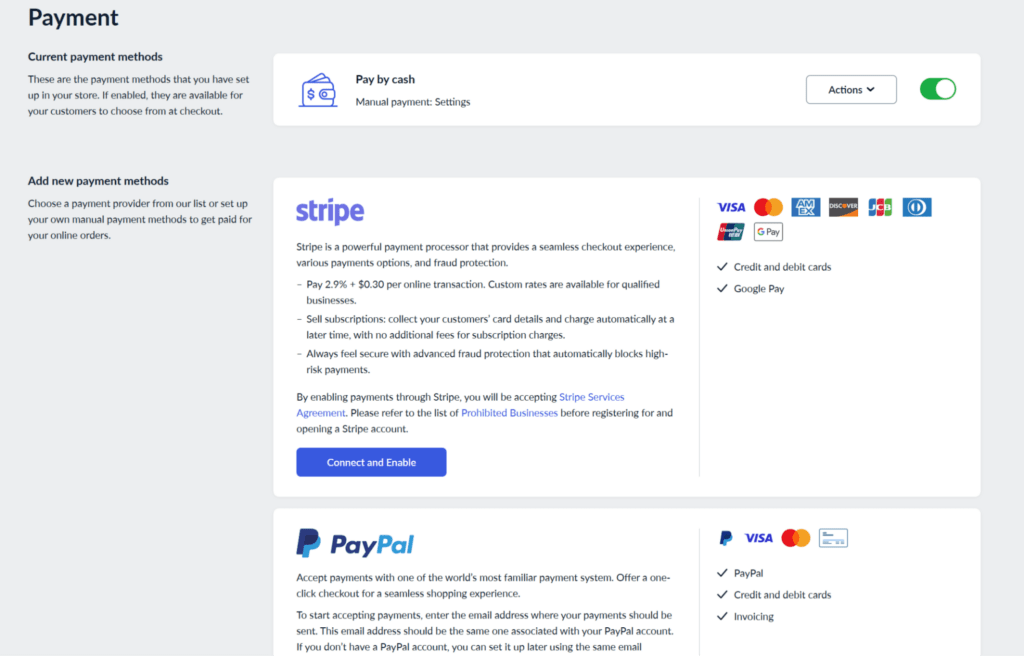
Ecwid, on the other hand, doesn’t charge additional transaction fees.
However, you still have to pay those charged by its supported payment providers, such as Stripe, PayPal, and more.
Winner: Ecwid
Ecwid wins thanks to its zero transaction fees, which helps brands, especially smaller ones, make a profit.
Power asserts that “If you’re dead set on maximizing your profit margins at every sale, then the lack of transaction fees will definitely appeal.”
Ecommerce features
Both Shopify and Ecwid come with different features, but it’s up to you to determine which are most important for your company.
Luckily, we’ve consolidated them to help you find your answer.
Shopify
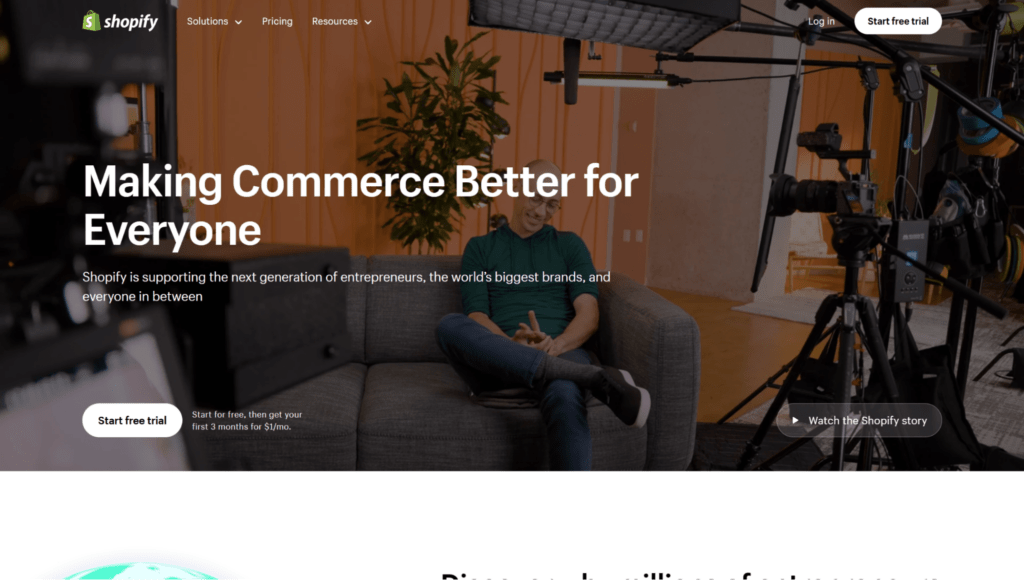
Selling on Shopify is all but limitless, thanks to its extensive features.
The platform lets you offer not only physical goods but also the non-physical, like services and digital products. Its toolkit covers business aspects including:
- Storefront creation and management
- Integration into other sales channels, such as marketplaces and social platforms
- In-person selling, thanks to Shopify POS
- Marketing and SEO
- Fulfillment and shipping
- International selling, through Shopify Markets
Not to mention, Shopify has a rich app ecosystem that lets you add never-ending store functionalities, and 24/7 customer support is also available.
Overall, it empowers ecommerce for small businesses and larger-scale enterprises alike.
Ecwid

Ecwid offers similar features, allowing you to:
- Build a website from scratch
- Offer physical and digital products
- Sell on various marketplaces and social platforms
- Market your brand
- Manage aspects of your store such as inventory and shipping
It provides enough functionalities for small to medium brands, but Ecwid’s app market is less vast and still lacks certain solutions that bigger businesses need.
Winner: Shopify
Regarding overall ecommerce functionality and future-proofing your business, Shopify provides all the design and functionality you may need as you grow—with enterprise support options to boot.
Shopify’s breadth of tools offers boundless potential for scaling, whereas Ecwid covers mostly the basics.
Customization and branding
Your website should be a digital manifestation of your brand, and your branding should match.
Let’s review which platform offers the best customization options so you can do your brand justice.
Shopify
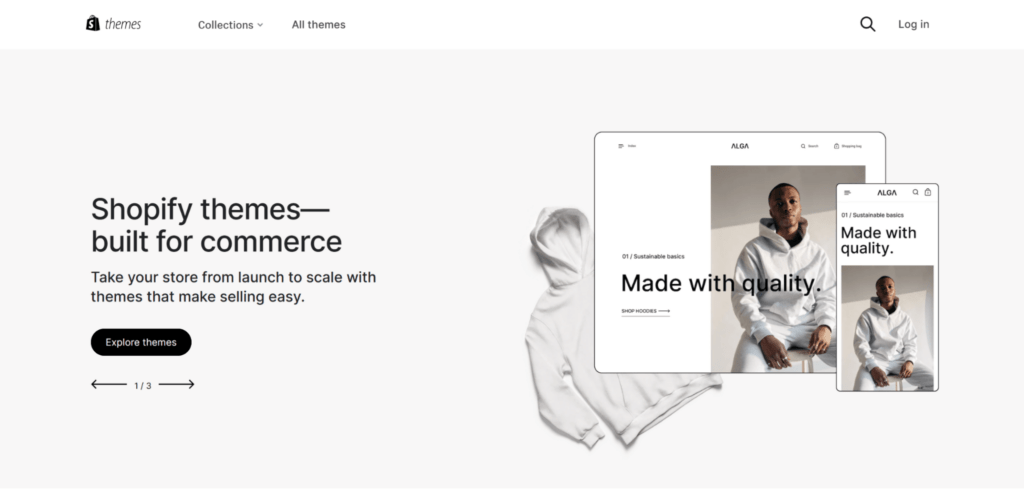
Shopify themes simplify the customization of your store aesthetics and serve as its foundation.
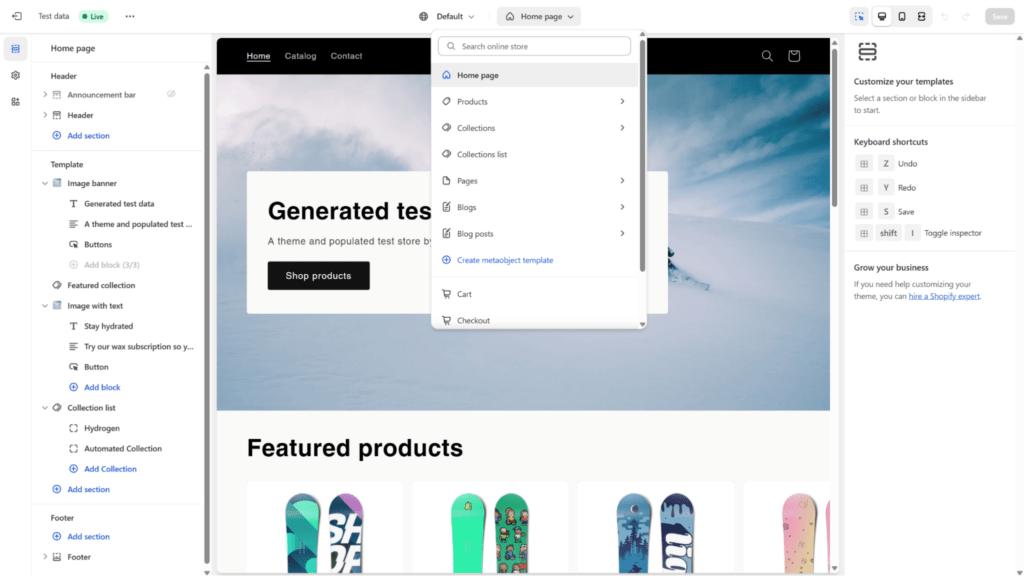
Page templates, meanwhile, ease the creation of individual pages. Shopify’s editor even offers a user-friendly interface.
For more intricate design work and a uniform aesthetic across your website, you can employ Shogun Page Builder, which lets you create templates for branded pages.

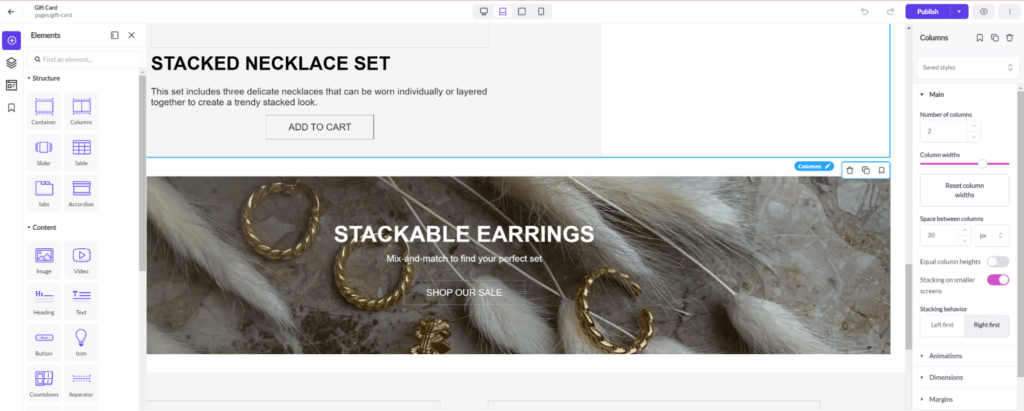
Its drag-and-drop functionality offers intuitive customization, allowing you to incorporate various elements such as images, text, and video seamlessly.
Ecwid

For its part, Ecwid offers themes and templates as well that let you easily tailor your store and pages.
However, its editor is less intuitive, with some beginners finding it confusing to tweak certain aspects of page design.
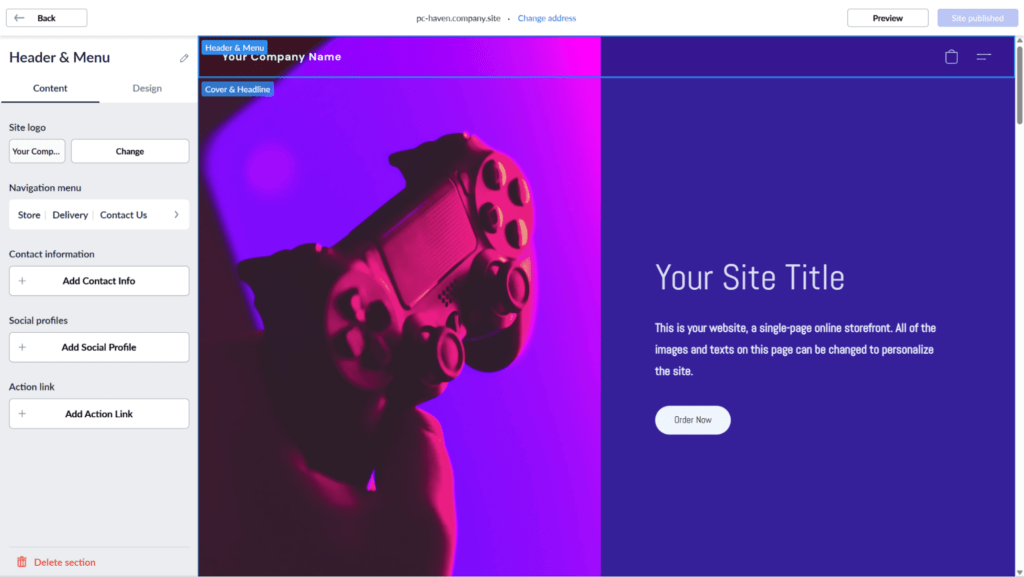
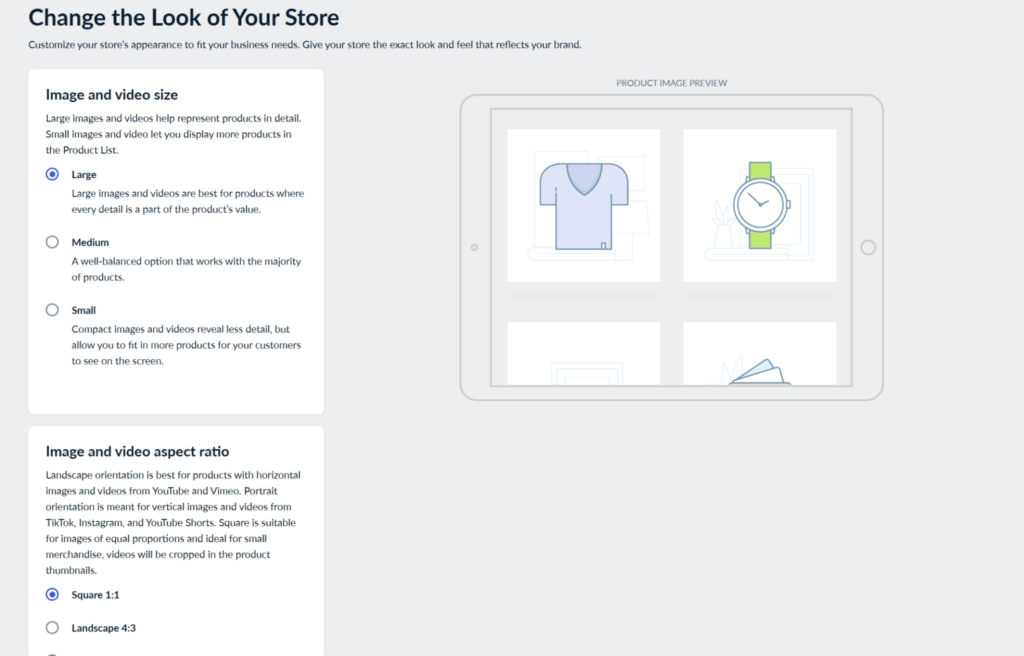
Although some options are available for altering your store’s appearance outside the editor, they’re noticeably limited.
Winner: Shopify
Shopify has the clear advantage, with its more robust customization and ability to equip businesses with everything needed to craft the perfect representation of their brand.
When making his choice, Michael Springer, CEO and founder of Opportunity Green, emphasized his need for “a platform that could provide … more flexibility in design and layout. It was important … to create a custom website rather than using one of the premade templates available on Ecwid.”
Ultimately, he found the best solution for those requirements in Shopify.
Marketing and SEO
Your website is likely your most powerful marketing tool. How do these platforms stack up when it comes to positioning your website for success and searchability?
Shopify
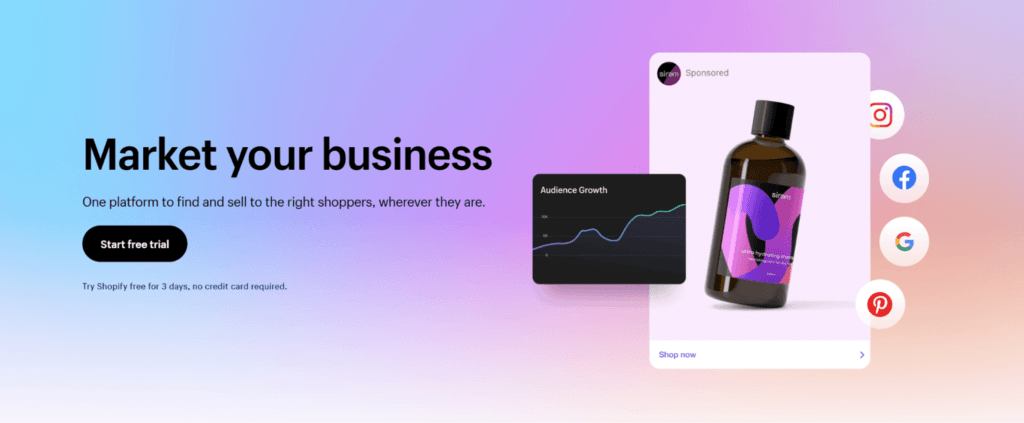
Shopify’s marketing functionalities are specifically designed for:
- Creating engaging blogs
- Conducting email campaigns
- Selling on social platforms
- Conversing with customers
- SEO
- Customer data collection and analysis, thanks to Shopify analytics
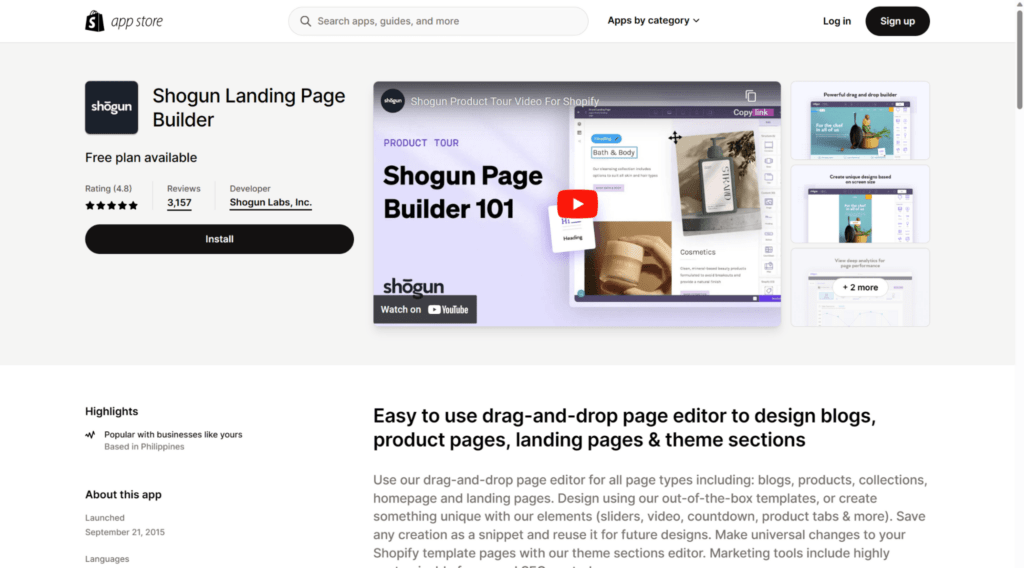
Meanwhile, the Shogun app allows you to build conversion-boosting landing pages that drive results for your marketing campaigns.
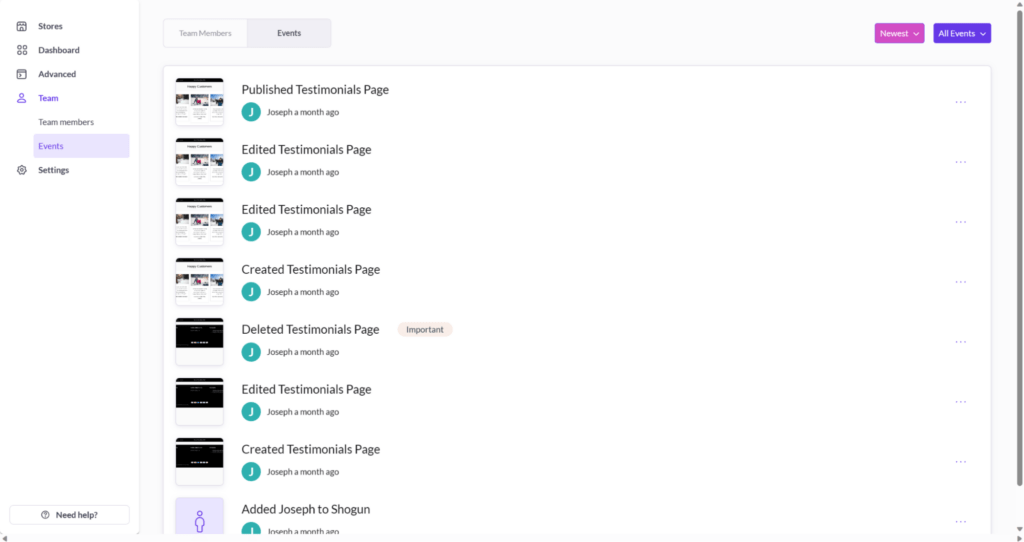
You can even bring in your entire marketing team to collaborate, check for results, and track any changes.
Ecwid
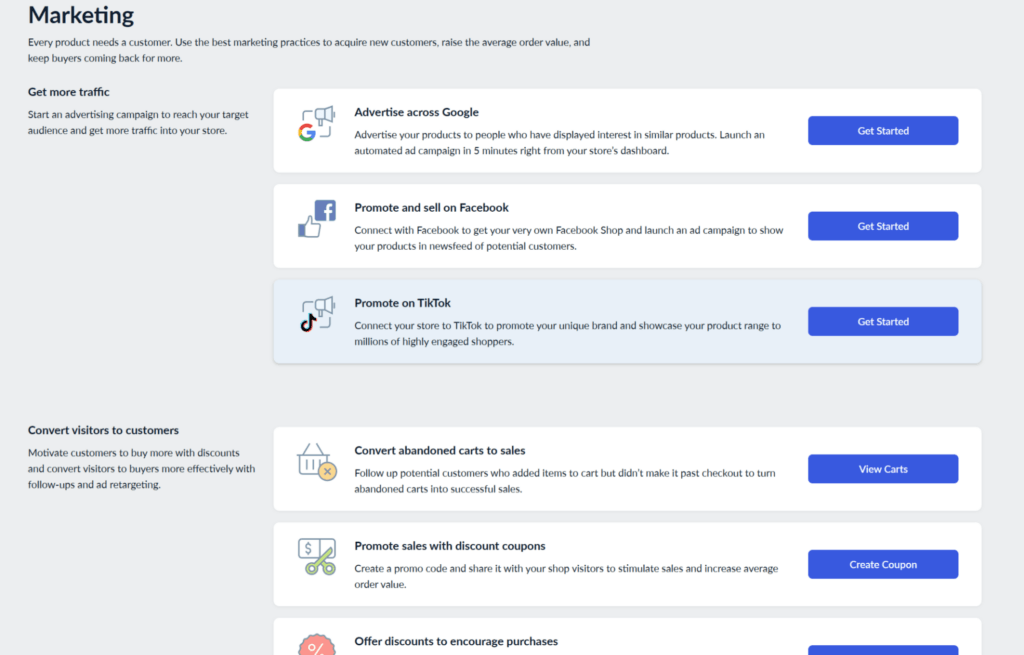
In comparison, Ecwid’s tools for marketing primarily focus on advertising across Google sites and social platforms.
They also let you offer discounts, conduct email campaigns, and measure results.
Winner: Shopify
In this category, Shopify offers a more well-rounded marketing suite compared to Ecwid. Its data capabilities even helped drive Tru Earth’s growth plans.
Co-founder & CMO Ryan Mckenzie raved how:
“Thanks to Shopify’s comprehensive analytics dashboard, we were able to monitor our customers’ behaviors and purchasing patterns. This offered us insightful data to optimize our marketing strategies, helping us skyrocket our growth by 944% in three years.”
Integrations and apps
When choosing your platform, you also need to look at extended functionality.
Your selection requires you to consider which platform will work with the other tools in your toolkit and also has the integrations you want.
Shopify

Shopify boasts a rich app ecosystem, offering various integrations that expand your website’s functionality.
Take the Shogun app, for instance, which greatly extends your design options. Other integrations serve different valuable purposes as well, including:
- Improving SEO and website performance
- Launching email marketing campaigns
- Offering subscriptions and loyalty programs
- Streamlining the shipping process
- Upselling
- Collecting and showcasing customer reviews
Ecwid
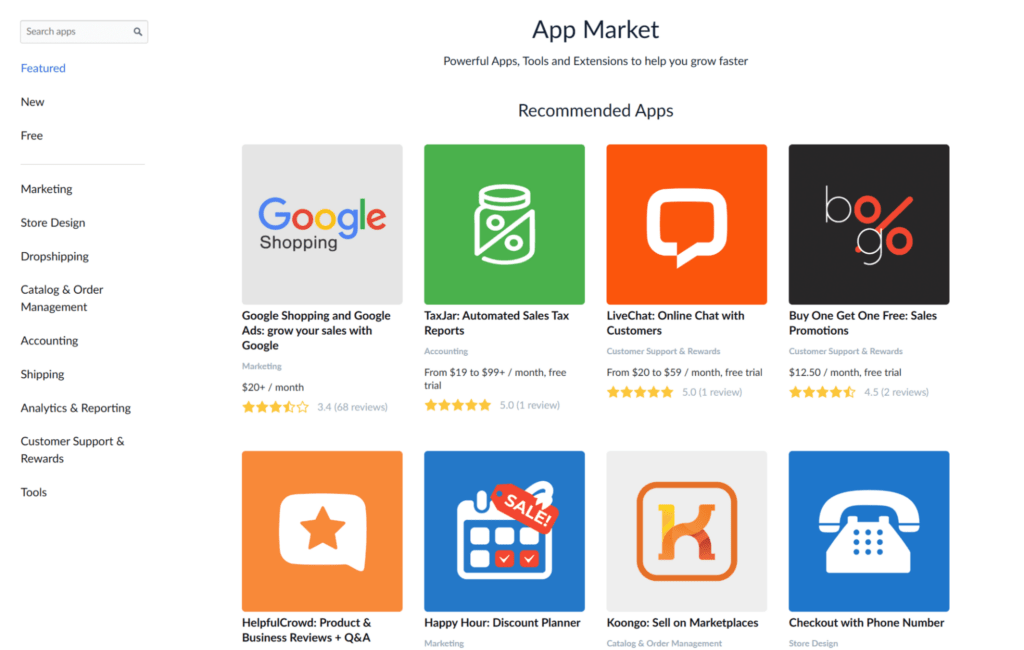
Ecwid offers its own app market as well, but again, the available selection isn’t as impressive.
Winner: Shopify
In terms of its broader range of available integrations and apps, Shopify outshines Ecwid.
A key aspect that stood out for Ryan Mckenzie:
“We were highly impressed by Shopify’s expansive ecosystem of integrations and third-party apps. Having a 360-degree view of our business operations, integrating our marketing tools, customer service, and supply chain management, all within one platform, was paramount.”
Omnichannel selling
The future of ecommerce is multichannel, wherein you have a presence on all of the sales channels your customers choose to shop: marketplaces, your own website, social media stores, and more.
However, pay attention to retail and in-person sales as well—your chosen platform should be able to support every portal you sell through.
Shopify
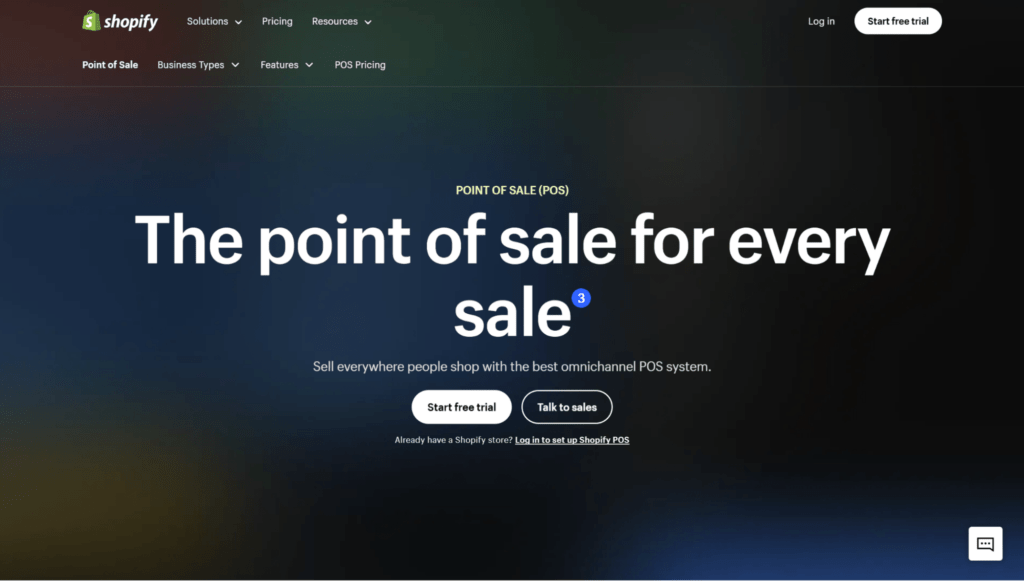
Shopify’s marketing toolkit enables selling on social platforms, and specific apps let you operate on online marketplaces such as Amazon, Walmart, and eBay.
The platform shines in multichannel selling thanks to Shopify POS, which provides seamless payment processing and inventory management between your online and offline sales.
It even offers staff management capabilities and POS hardware.
Ecwid

As previously mentioned, Ecwid prioritizes connecting with various online channels.
It also offers a POS system that has functionalities similar to Shopify’s, such as payment processing and inventory syncing.
What it lacks, however, is staff management capabilities and POS hardware—both of which are available through Shopify.
Winner: Shopify
If you want to expand to retail stores and omnichannel selling, you need to be ready for exponentially greater peak sales.
For every retail store, you can expect another roughly $30,000 of revenue—depending on your ecommerce revenue, this could mean doubling your sales with every new branch or sales channel.
Although both Shopify and Ecwid offer a POS, Shopify has a greater capacity for scale and a more comprehensive offering of software and physical tools.
According to Mckenzie, “Shopify’s robust platform and seamless ability to handle increased customer traffic, even during peak times, made it a conducive choice” to accommodate Tru Earth’s projected growth.
Shipping and fulfillment
Although not typically expected of your sales channels, some ecommerce platforms go above and beyond to help you deliver your goods.
Amazon sellers, for instance, can use the FBA network.
At a basic level, consider which platforms are the most reliable and will make it easy for you to synchronize orders and inventory for your deliveries.
Shopify

Shopify’s Fulfillment Network simplifies shipping and fulfillment so merchants can benefit from the platform’s transportation partnerships.
It handles inventory storage, returns processing, distribution, delivery, and more.
Ecwid

Ecwid’s shipping and fulfillment, meanwhile, primarily focuses on discounted USPS shipping, but it lets you add local, international, and self-pickup options as well.

Winner: Shopify
With its emphasis on simplicity and streamlining, Shopify’s Fulfillment Network can address any business’s fulfillment needs.
That ease of use was a major boon for Opportunity Green, which faced issues with product delivery. Michael Springer explained that Shopify removed the company’s fulfillment obstacles:
“A pre-built option is available on the platform, and [products] can be shipped in several ways from the site. You can even choose a fixed charge for shipping or an individual shipping cost for each item.”
Security
With ecommerce fraud a common problem, strong store security is a must.
Shopify and Ecwid both take this aspect seriously and are compliant with PCI DSS (Payment Card Industry Data Security Standard) and GDPR (General Data Protection Regulation) regulations.
But the key difference is that Shopify has received Service Organization Control (SOC) 2 Type II and SOC 3 reports from auditors and provides a transparency report.
Winner: Shopify
Although both platforms provide robust security, Shopify takes it a step further by enforcing extra measures to protect its merchants and their customers.
“The platform’s stringent security measures, such as Level 1 PCI compliance and SLL certification, reassured us about the safety of our customer’s data,” Mckenzie said in appreciation of Shopify’s commitment to store protection.
Customer support
Shopify offers 24/7 support through chat, or you can leave a message. You can also find support through the Shopify Community.
Ecwid’s options, on the other hand, have plan-based limitations. Communication channels can range from email to chat and phone. Phone support, however, has a specific schedule of availability.
Winner: Shopify
Shopify supports merchants around the clock through various channels.
Despite lacking phone support, it doesn’t impose plan-based limitations like Ecwid, making it easier for merchants to get in contact no matter their subscription tier.
Shopify vs Ecwid FAQs
Now that you know where Shopify and Ecwid each shine, here are the answers to typical questions about the platforms.
What’s the difference between Shopify and Ecwid?
Shopify offers a powerful, intricate ecommerce solution, while Ecwid focuses more on your website’s easy integration with other channels.
The biggest difference lies in each one’s scalability: Shopify can drive larger enterprises, while Ecwid is ideal for small to medium-sized businesses.
What are the downsides of Ecwid?
Ecwid’s drawbacks are mainly associated with its:
– Less-advanced features that limit scalability
– Lack of design flexibility
– Smaller library of apps and integrations
Is there an Ecwid Shopify integration?
Yes, there are many different ways you can use the two platforms simultaneously. For example, Integrately, Appy Pie, and Zapier all have Ecwid Shopify integrations.
You may also build your website on Ecwid and use the Shopify Buy Button to leverage Shopify’s payment infrastructure and checkout process.
Although the two platforms can work together in many ways, we don’t recommend using both as you’d be doubling your fees to use features that the other option likely already has.
Plus, it adds additional complexity to your store setup, which introduces more opportunities for errors.
Can I switch from Ecwid to Shopify?
If you already have an Ecwid store and decide that Shopify is the better platform for your brand, you can move your store over either manually or with the help of a migration tool.
Shopify has some guidelines for migrating to Shopify, and we recommend using software to help move your data over without anything falling through the cracks.
A few different tools you can use include LitExtension, Cart2Cart, and Next-Cart.
Who should use Ecwid?
Ecwid’s lower costs make it more suitable for small to medium-sized businesses that want to maximize profits but aren’t looking to scale.
Who is Shopify best suited for?
Shopify is ideal for businesses of all sizes looking for a highly advanced ecommerce platform. Its ability to scale up also makes it a superb choice for enterprises or those looking to grow.
Is it free to sell on Ecwid?
Yes, Ecwid offers a free plan that lets you sell at no cost. But for more features and flexibility, we recommend its higher-tier plans.
Shopify for more growth potential, Ecwid for easier ecommerce entry
Merchants in search of a platform that can grow alongside their brand should use Shopify.
Its extensive toolkit and app library helps with store customization, management, and multichannel selling, offering everything you’ll need now and in the future.
Meanwhile, smaller, simpler stores should choose Ecwid.
Its low costs provide an easy launch pad for online businesses, and its set of features is just right for those not looking to scale.
Your business’s unique needs and priorities will determine whether Shopify or Ecwid is the right platform, but keep these considerations in mind, as well as the other points outlined in this article, during your selection to feel confident with your choice.
#cta-visual-pb#<cta-title>Build a website that grows with you<cta-title>Use Shogun Page Builder to design a timeless Shopify store, discover what makes your customers convert, and collaborate with your growing team to optimize for sales.Start building for free

Rachel Go
Rachel is a remote marketing manager with a background in building scalable content engines. She creates content that wins customers for B2B ecommerce companies like MyFBAPrep, Shogun, and more. In the past, she has scaled organic acquisition efforts for companies like Deliverr and Skubana.



